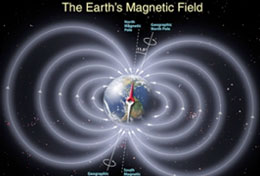Topic: Magnetic Compass
Teacher Resources:
Printable PDF Version of this Lesson Plan
Downloadable PPT of Lesson (2mb)
Lesson 4 Handout – Magnetic Compass Exercise (PDF)
Primary Goal : Explain to students the science behind how a magnetic compass works and allow them to practice taking bearings using a hand-bearing magnetic compass.
Lesson Objectives :
· Understand the history and importance of the magnetic compass
· Understand the science behind how a magnetic compass works
· Ability to personally use a compass and take bearings
Lesson Outline :
I. History of the Magnetic Compass
a. Origins are unknown but go back over one thousand years
i. Record of use by Chinese and ancient explorers for both land and sea navigation
ii. Allowed sailors to sail over the horizon without risk of being lost at sea
b. Earliest compass consisted of iron ore lodestone floating in a bowl of water and later adaptations included modifications for use at sea
i. Most vessels today, from the personal sailboat to the large merchant ship, are all equipped with a magnetic compass
II. Parts of a Magnetic Compass
a. Direction of Travel Arrow – the red arrow on the baseplate which you will point in the direction you intend to travel or take a bearing
b. Magnetic Needle – free floating piece of metal that always aligns its red half to the magnetic north pole
c. Bezel –rotating dial that has the cardinal headings and degree markings
d. Orienting Arrow – the red arrow within the compass housing
i. Also called “dog house” because it looks like a house and you will attempt to put the needle (“dog”) in the “dog house”
III. How a Magnetic Compass Works
a. Earth’s magnetic field is a closed circulation of electrical currents that flow North or South
b. Magnetized needle is free to move and align with the Earth’s magnetic field and thus follows the direction of the earth’s current
c. “Basic Law of Magnetism” – poles of the same polarity repel each other and those of opposite polarity attract. Think of the earth as having an internal bar magnet extending along its axis from North Pole to South Pole.
d. The compass always points in the same direction. It is the face of the compass that rotates and contains markings that display the precise direction the user is facing.
IV. Benefits of Magnetic Compass
a. Self-contained system that is not reliant on electrical power and is not easily damaged or expensive to replace
V. Using a Hand-Bearing Magnetic Compass
a. Line up the sliding line with the intended object and read of the degrees below
b. Be sure to not take measurements near metal objects, as this will affect your readings. The earth’s magnetic field is actually quite weak. That is why we need an almost frictionless pivot point for our lightweight needle.
c. Wait a few seconds until the compass has settled before taking a reading
Supplemental Resources :
True vs. Magnetic North Video: https://www.youtube.com/watch?v=ieW7Hzrr8pw
Navigation Video by Nautica : http://www.nauticalive.com/navigation/
Exercises/Activities :
Take students outside and allow them to use a hand-bearing compass to take bearings of landmarks on campus. Set up specific stations around campus and create competition to see who can get closest to actual bearing (see Magnetic Compass Exercise worksheet).
Create your own compass by magnetizing an ordinary needle, placing it carefully on a slice of cork, and letting the cork float in a tray of water.
![]()




